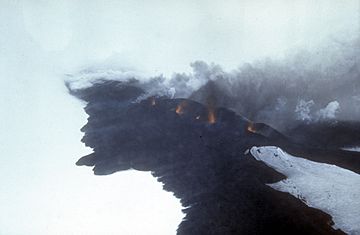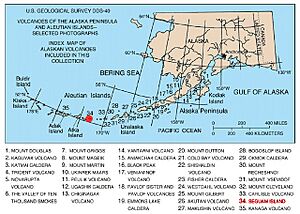Pyre Peak facts for kids
Quick facts for kids Pyre Peak |
|
|---|---|

Incandescent lava fountaining from a fissure eruption near Pyre Peak on Seguam Island.
|
|
| Highest point | |
| Elevation | 3,458 ft (1,054 m) |
| Prominence | 3,458 ft (1,054 m) |
| Isolation | 60.68 mi (97.65 km) |
| Geography | |
| Location | Seguam Island, Alaska, U.S. |
| Parent range | Aleutian Range |
| Topo map | USGS Seguam D-2 |
| Geology | |
| Mountain type | Stratovolcano |
| Volcanic arc/belt | Aleutian Arc |
| Last eruption | 1993 |
Pyre Peak, also known as Seguam Volcano, is an active stratovolcano located on Seguam Island. This island is part of the Aleutian Islands in Alaska, United States. It's a tall, cone-shaped mountain that has erupted in the past.
Contents
What is Pyre Peak?
Pyre Peak is a type of volcano called a stratovolcano. Imagine a giant cone-shaped mountain. That's often what a stratovolcano looks like! These volcanoes are built up over many years. They form from layers of hardened lava, ash, and rocks from past eruptions.
Where is Pyre Peak Located?
Pyre Peak stands on Seguam Island. This island is a small, remote place in the Aleutian Islands. The Aleutian Islands are a long chain of islands that stretch out from the main part of Alaska. They are known for having many volcanoes.
The Aleutian Arc
Pyre Peak is part of the Aleutian Arc. This arc is a curved line of volcanoes. It formed where two of Earth's giant plates meet. One plate slides under the other. This process creates magma, which then rises to the surface, forming volcanoes.
How Tall is Pyre Peak?
Pyre Peak reaches a height of about 3,458 feet (1,054 meters). That's taller than many big buildings! Its height makes it a prominent feature on Seguam Island.
When Did Pyre Peak Last Erupt?
Pyre Peak is an active volcano. This means it could erupt again. Its last known eruption happened in 1993. Volcanoes can be quiet for a long time. Then they can become active again. Scientists keep a close watch on active volcanoes like Pyre Peak.
Understanding Stratovolcanoes
Stratovolcanoes are also called composite volcanoes. They are known for their steep slopes and explosive eruptions.
How Stratovolcanoes Form
- Magma (molten rock) rises from deep inside the Earth.
- It erupts as lava, ash, and rock fragments.
- These materials cool and harden in layers.
- Over many eruptions, these layers build up. They create the tall, cone shape we see.
Types of Eruptions
Stratovolcanoes often have powerful, explosive eruptions. This is because the magma inside them is thick and sticky. It traps gases, which build up pressure. When the pressure is too much, the volcano erupts with force. This can send ash high into the sky. It can also cause fast-moving flows of hot gas and rock.
Why Study Pyre Peak?
Studying volcanoes like Pyre Peak helps scientists understand our planet better. It also helps them predict future eruptions. This is important for the safety of people living near volcanoes. Even though Seguam Island is remote, understanding its volcanoes helps us learn about similar ones around the world.


